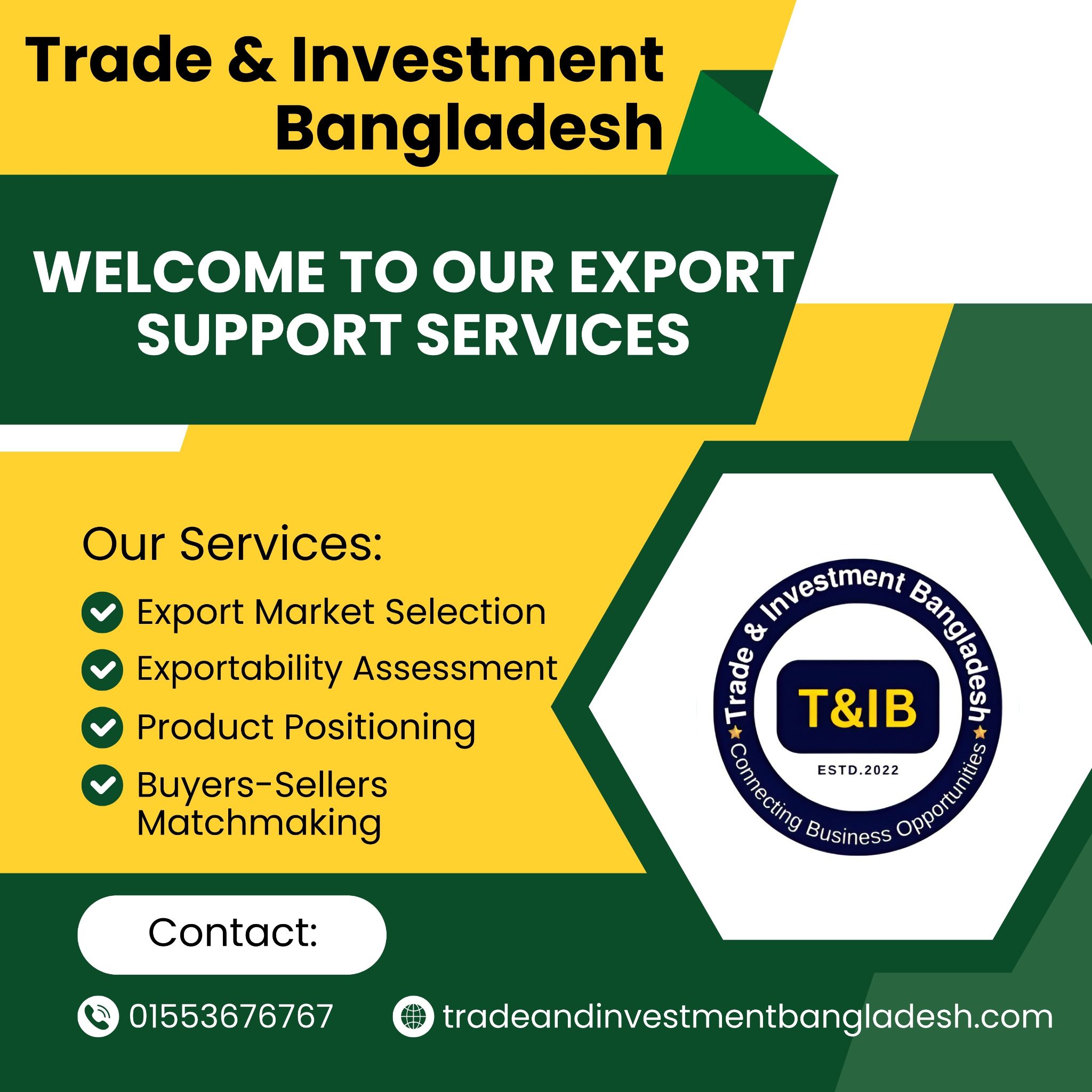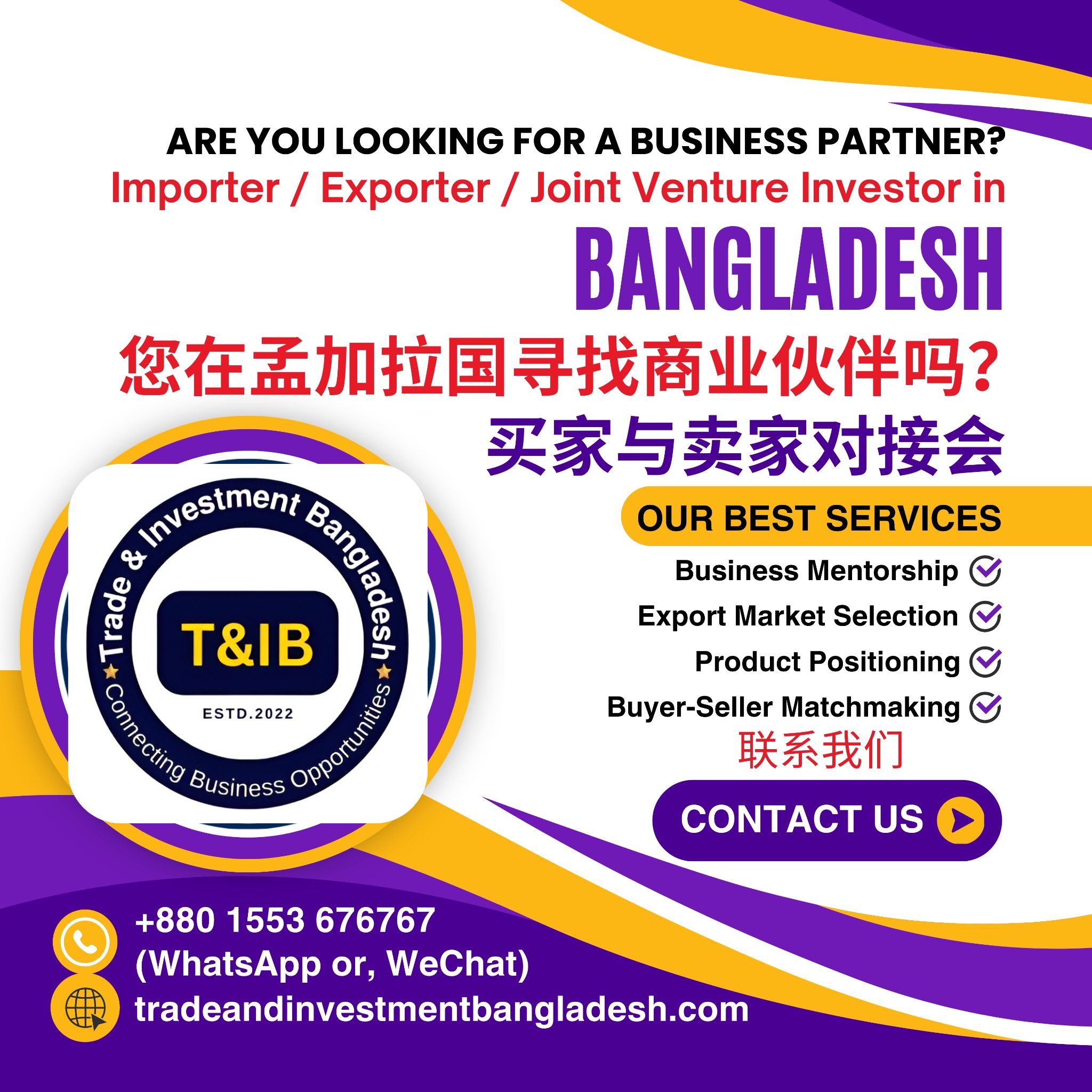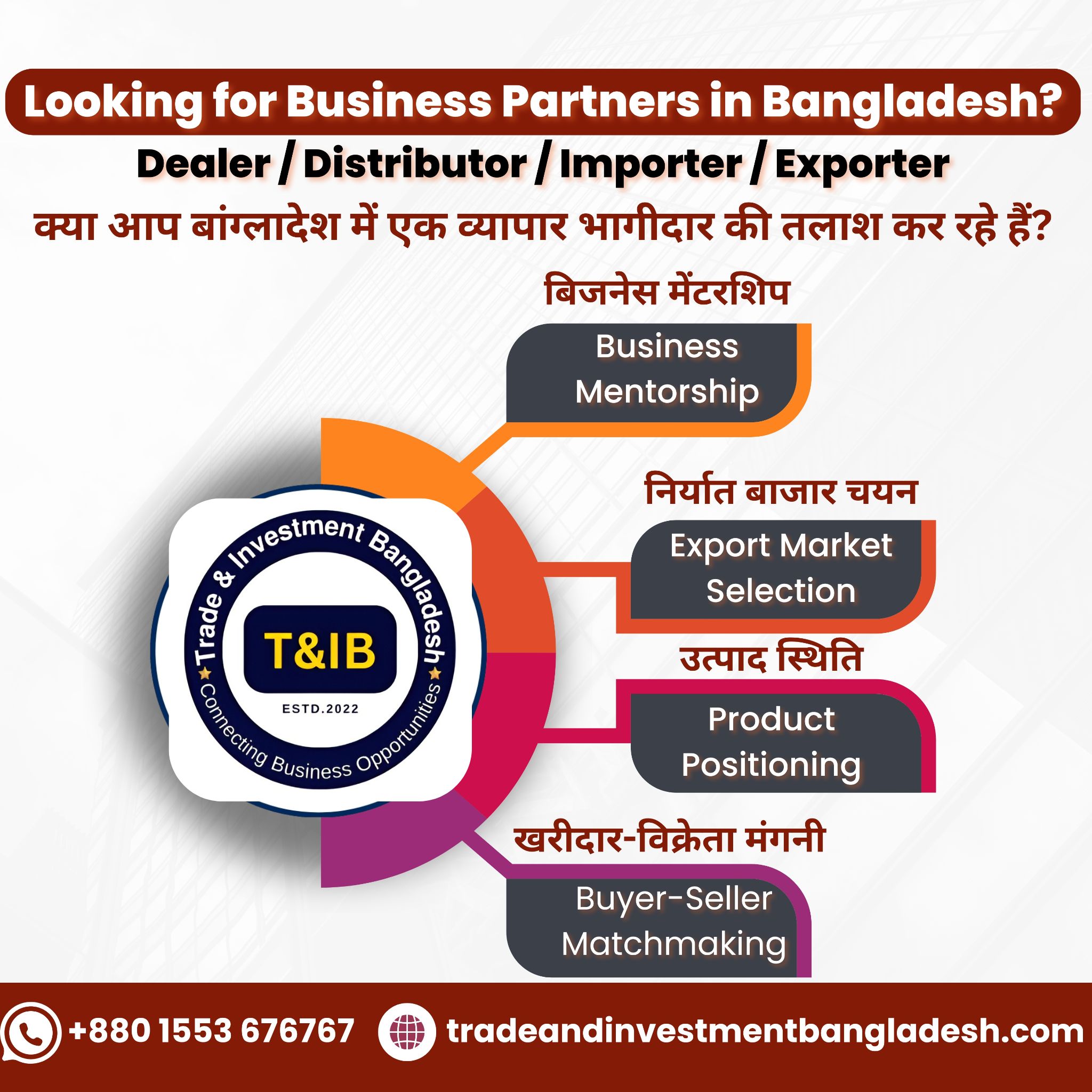Essential Skills for Export Marketing Success
Founder & CEO, Trade & Investment Bangladesh (T&IB)
Executive Director, Online Training Academy (OTA)
Secretary General, Brazil Bangladesh Chamber of Commerce & Industry (BBCCI)
In today’s globally integrated economy, export marketing is no longer a luxury reserved for large multinational corporations it has become a strategic imperative for businesses of all sizes aiming to expand beyond domestic boundaries. The World Trade Organization reported that global merchandise trade reached a staggering $25.3 trillion in 2022, underscoring the immense potential that lies in international markets. Developing countries alone contributed nearly 44% to this global trade volume, a figure that highlights both the growing competitiveness and opportunity across the globe. However, while the promise of global trade is vast, many businesses especially small and medium-sized enterprises (SMEs) face significant barriers when attempting to enter or scale in export markets. These challenges often stem from a lack of specialized marketing knowledge, limited understanding of international trade dynamics, and insufficient digital readiness. It’s clear that achieving success in export marketing goes far beyond simply offering products to a foreign audience; it requires a strategic, research-driven, and culturally adaptable approach.
Export marketing success depends heavily on the ability to research and understand international markets effectively. This involves gathering accurate data on trade flows, identifying demand trends, evaluating competitor activity, and navigating complex tariff structures and regulations. Tools like the International Trade Centre (ITC) Trade Map offer exporters valuable insights by providing detailed statistics on trade volumes, top import and export countries, and performance indicators that help businesses make data-informed decisions. Similarly, the ITC Market Access Map equips exporters with critical information on tariffs, trade agreements, and non-tariff measures that may affect product pricing and entry feasibility. Another vital tool, the ITC Standards Map, helps businesses align with international voluntary standards such as environmental, social, and safety certifications required by many foreign buyers. Despite the availability of such powerful tools, studies show that over 60% of SMEs fail in their export ventures due to poor planning, limited market intelligence, and weak outreach strategies. This failure rate illustrates the importance of developing strong analytical and strategic planning skills as a foundation for any export marketing initiative.
As the global marketplace becomes increasingly digital, traditional marketing methods are no longer sufficient. Exporters must adopt modern digital marketing techniques to reach and engage with international buyers effectively. With 97% of B2B buyers now using online search engines and platforms to research suppliers and products, businesses that lack digital visibility are at a significant disadvantage. Skills such as Search Engine Optimization (SEO) help exporters appear in relevant searches in target markets, increasing their visibility without relying solely on paid advertising. Meanwhile, tools like email extraction software enable exporters to build targeted contact lists of potential buyers, distributors, and agents in specific countries or industries. When combined with effective email marketing, CRM (Customer Relationship Management) systems, and social media outreach, businesses can create personalized, data-driven campaigns that build trust and foster long-term partnerships. The benefits are clear: higher lead generation, lower marketing costs, better engagement, and ultimately, a stronger foothold in foreign markets. As such, mastering digital tools and communication strategies is just as essential as understanding logistics and compliance in the pursuit of global growth.
02. Market Research & Analysis Skills
One of the most critical foundations of export marketing success lies in the ability to conduct effective market research and analyze international data. Export marketers must go beyond surface-level insights and develop a deep understanding of the demand patterns, competitive landscape, pricing structures, and trade barriers in each target market. This involves not only collecting information but also interpreting complex data to guide strategic decisions—such as which countries to enter, how to position products, and what pricing models to adopt.
To support this analytical process, a range of specialized tools is available to exporters. Among the most valuable is the ITC Trade Map, a comprehensive platform developed by the International Trade Centre that provides detailed statistics on global trade flows. This tool allows businesses to assess which countries import specific products in high volumes, identify potential high-demand markets, evaluate current trends, and monitor key competitors’ performance across borders. With this data, businesses can target markets with higher demand and lower saturation, giving them a strategic advantage.
Another indispensable resource is the ITC Market Access Map, which offers updated information on import tariffs, trade agreements, and non-tariff measures such as quotas or licensing requirements. This tool is particularly useful for ensuring that pricing strategies account for additional costs associated with market entry. By understanding tariff structures in advance, exporters can determine whether a product will remain competitively priced after duties are applied, or whether regional trade agreements might offer preferential access.
Equally important is the ITC Standards Map, which provides valuable insight into voluntary standards and certification schemes that are often required or preferred by buyers in certain industries or regions. These standards may relate to sustainability, safety, labor practices, or environmental compliance. For exporters, aligning their products with these expectations not only helps meet buyer requirements but also adds credibility and appeal in competitive global markets.
Together, these tools empower export marketers to make well-informed decisions that minimize risk and maximize opportunity. By mastering market research and analysis skills, and effectively utilizing platforms like the Trade Map, Market Access Map, and Standards Map, exporters can identify the most promising markets, ensure compliance, and tailor their strategies for successful international expansion.

03. Digital Marketing & Online Visibility
In the digital age, the journey of reaching international buyers often begins long before a handshake or a signed contract it starts with an online search. As most B2B and B2C buyers turn to the internet to discover products, compare options, and validate suppliers, the importance of having a strong online presence cannot be overstated. For exporters, digital marketing is not merely a promotional tactic it is a strategic necessity for visibility, credibility, and lead generation across global markets.
At the core of digital visibility lies Search Engine Optimization (SEO). This involves optimizing a company’s website and online content so that it ranks higher in search engine results when potential buyers search for relevant products or services. For instance, if an exporter from India supplies organic spices, a well-executed SEO strategy would ensure that when an international buyer searches for “bulk organic turmeric supplier,” that exporter’s website appears on the first page. SEO is especially valuable because it generates organic (unpaid) traffic from target countries, increasing visibility while reducing long-term marketing costs. Exporters can use localized keywords, multilingual content, and technical improvements to attract and retain international traffic effectively.
Beyond visibility, building direct relationships with potential buyers is essential and this is where email marketing and outreach come into play. Export marketers can use email campaigns to introduce products, share catalogs, offer deals, and establish rapport with importers, distributors, or agents abroad. To enhance this process, tools such as email extraction software help identify and collect contact details from trade directories, business websites, and social platforms, ensuring that outreach efforts are highly targeted. These contacts can then be managed through Customer Relationship Management (CRM) platforms like HubSpot or Zoho, which allow marketers to track communication, schedule follow-ups, and personalize engagement based on buyer behavior and interests.
In addition to search and email, social media marketing has become a powerful channel for global brand building. Platforms like LinkedIn are particularly effective for B2B exporters, as they allow businesses to showcase expertise, share success stories, and connect with decision-makers in specific industries or regions. Meanwhile, Instagram and Facebook offer visual storytelling opportunities, especially useful for products with strong design, lifestyle, or aesthetic appeal. Through consistent posting, engagement, and targeted content, exporters can build brand recognition and trust among international audiences especially in niche or emerging markets where personal connection still drives purchase decisions.
Finally, digital advertising through platforms like Google Ads and Meta Ads (Facebook & Instagram Ads) provides a way to reach highly specific international demographics quickly. Exporters can design campaigns that target users in particular countries, industries, or age groups, using precise keywords and audience filters. For example, a textile exporter in Bangladesh can create a campaign specifically targeting fashion retailers in Germany, promoting eco-friendly fabric lines. The benefit of digital ads lies in their measurability, scalability, and speed allowing businesses to test markets, generate leads, and adapt their messaging in real time.
In essence, digital marketing is the gateway to global opportunities. When executed strategically, it enables exporters to not only be found by international buyers but also to engage, educate, and convert them into long-term partners.
04. Cross-Cultural Communication & Negotiation
One of the most often overlooked yet critically important skills in export marketing is the ability to communicate and negotiate effectively across cultures. While data, strategy, and logistics play essential roles, it is the personal interactions with foreign clients, distributors, and partners that often determine the success or failure of international deals. Export marketers must be able to navigate a wide range of cultural norms, business etiquettes, and communication styles in order to build trust and maintain strong professional relationships around the world.
At the heart of cross-cultural communication lies the understanding of local customs and etiquette. What is considered polite, persuasive, or professional in one culture may be perceived quite differently in another. For example, in Japan, formal introductions, business card exchanges, and indirect communication are valued, whereas in Germany, clarity, punctuality, and efficiency in communication are highly regarded. An export marketer who understands and respects these cultural nuances is more likely to earn the trust and respect of their international counterparts. This sensitivity not only enhances the quality of interactions but also signals professionalism and commitment to a long-term partnership.
Another essential aspect of effective cross-border communication is clear and concise proposal writing. Export marketers often engage in presenting product offers, quotations, and business proposals to foreign buyers who may not speak English as a first language or may rely on translated documents. In such cases, simplicity, clarity, and organization of content are key. Proposals should avoid jargon, clearly state terms, include visual aids such as product images or infographics, and offer transparent pricing and shipping terms. A well-structured proposal demonstrates professionalism and reduces the likelihood of misunderstandings, paving the way for smoother negotiations.
Finally, successful negotiation in international markets requires an awareness of different cultural approaches to business discussions. Some cultures prioritize relationship-building and consensus, taking time before making decisions common in countries like India or Brazil while others, such as the United States or the Netherlands, may prefer direct, result-oriented negotiations. Export marketers must adapt their negotiation strategies accordingly, balancing assertiveness with cultural sensitivity. Understanding when to be flexible, when to hold firm, and how to frame offers in culturally acceptable ways can significantly influence deal outcomes. Moreover, skilled negotiators who respect cultural differences are more likely to build sustainable, win-win partnerships that go beyond one-time transactions.
In a global marketplace where success depends as much on interpersonal rapport as it does on product quality or pricing, mastering cross-cultural communication and negotiation is indispensable. These soft skills foster mutual respect, minimize conflict, and create a smoother path to collaboration, making them a core component of export marketing excellence.

05. Legal & Regulatory Knowledge
In the world of export marketing, understanding legal and regulatory frameworks is not just a matter of compliance it is a crucial safeguard against costly mistakes, delays, and disputes. Exporters operate in a highly regulated environment where even a minor oversight in documentation or an unfamiliarity with local customs regulations can result in shipment rejections, financial penalties, or damage to business relationships. Therefore, having a strong grasp of international trade laws, documentation protocols, and cross-border regulations is essential for minimizing risk and ensuring smooth and successful export operations.
One of the most fundamental areas of legal knowledge in exporting revolves around INCOTERMS the internationally recognized set of trade terms published by the International Chamber of Commerce. These terms clearly define the responsibilities of buyers and sellers with regard to transportation costs, insurance, risk transfer, and delivery points. For instance, understanding the difference between terms like FOB (Free on Board), CIF (Cost, Insurance, and Freight), or DDP (Delivered Duty Paid) can help exporters accurately quote prices, negotiate terms, and avoid misunderstandings related to who bears the cost or liability at various stages of shipping. When applied correctly, INCOTERMS reduce ambiguity and provide a common language that both parties can rely on, regardless of their country or native language.
Equally important is the ability to manage and produce the correct export documentation, which serves as both a legal requirement and a communication tool between the seller, buyer, carrier, and customs authorities. Key documents such as the Commercial Invoice, Certificate of Origin, and Bill of Lading are essential for proving ownership, verifying the value and nature of goods, and facilitating the movement of cargo across borders. The Commercial Invoice outlines product details, pricing, and terms of sale, while the Certificate of Origin authenticates the country where the goods were manufactured often needed to claim tariff benefits under trade agreements. The Bill of Lading, on the other hand, acts as both a shipping receipt and a document of title, allowing the buyer to claim the goods upon arrival. Mastery over the preparation and submission of these documents ensures faster customs clearance, accurate tax assessment, and compliance with destination country regulations.
In addition to documentation, exporters must navigate the complex landscape of customs procedures and regulatory barriers, which vary significantly from one country to another. This includes understanding import restrictions, licensing requirements, product safety standards, and labeling rules. For instance, certain countries may impose quotas on specific goods, require pre-shipment inspections, or mandate specific labeling in the local language. Failure to comply with these regulations can lead to goods being held at port, returned to origin, or even confiscated. Export marketers who are well-informed about these procedures can plan ahead, avoid costly disruptions, and maintain a reliable reputation among international buyers.
By building a solid foundation in trade laws and regulatory compliance, exporters not only protect themselves from legal risks but also gain a competitive edge. Buyers and partners are more likely to trust and prefer doing business with suppliers who demonstrate professionalism, reliability, and an in-depth understanding of global trade requirements. In this way, legal and regulatory knowledge becomes a powerful enabler of smooth operations, strong partnerships, and sustained success in international markets.
06. CRM & Lead Management
In export marketing, discovering potential buyers is just the beginning; the real success lies in nurturing those leads, maintaining meaningful engagement, and converting interest into long-term partnerships. With buyers spread across multiple countries and time zones, manual tracking of communications and opportunities can quickly become inefficient and disorganized. That’s where Customer Relationship Management (CRM) systems step in offering exporters a structured, centralized, and intelligent way to manage all buyer interactions and sales processes.
Modern CRM platforms like HubSpot, Zoho CRM, and Salesforce are purpose-built to help businesses keep track of every lead, from the first point of contact to post-sale follow-ups. These tools allow exporters to store detailed contact profiles, including email addresses, job titles, past communication history, interests, and deal progress. For instance, if a potential buyer from Germany downloads a product catalog or requests a price quote, that interaction is logged and can trigger an automated follow-up email, a reminder for a sales call, or an update in the sales pipeline. This not only saves time but also ensures that no opportunity is lost due to oversight or poor timing.
One of the greatest advantages of CRM systems in export marketing is their ability to track buyer engagement across multiple channels. Whether it’s monitoring who opened an email campaign, clicked on a brochure, or visited a product page, these insights allow exporters to prioritize leads based on interest levels and personalize their outreach accordingly. A highly engaged buyer from a target country, for example, can be flagged as “hot,” prompting the sales team to act swiftly with a customized proposal or an invitation to a virtual meeting. This data-driven approach makes the sales process more efficient, targeted, and effective.
Furthermore, CRMs offer valuable automation features that reduce manual workload while improving consistency. Automated workflows can send welcome emails, follow-up messages, or notifications to the sales team when a lead reaches a certain stage in the funnel. This is particularly beneficial when managing hundreds of leads from different regions, each requiring personalized attention. CRM tools also come with reporting dashboards, allowing export marketers to analyze trends such as which markets are responding best, what percentage of leads are converting, and how long deals typically take to close. These insights enable smarter decision-making and continual improvement of international sales strategies.
In essence, using a CRM system transforms lead management from a scattered, reactive process into a strategic, proactive one. It ensures that every inquiry, interaction, and opportunity is recorded, monitored, and followed through with precision. For exporters looking to scale their outreach, improve customer relationships, and grow globally, CRM platforms are not just tools—they are indispensable allies in building structured, sustainable export success.

07. Conclusion:
In the rapidly evolving landscape of global trade, success in export marketing is no longer driven solely by product quality or pricing it hinges on a well-balanced synergy between human intelligence and digital innovation. Marketers who blend traditional skills like market research, cross-cultural communication, and negotiation with modern tools such as SEO, CRM systems, and ITC databases are far better positioned to thrive. According to the International Trade Centre, 75% of small and medium-sized exporters that adopted digital tools for market analysis and outreach reported faster market entry and stronger lead generation. This demonstrates how technological tools not only enhance accuracy and efficiency but also empower marketers to make smarter, data-backed decisions in highly competitive environments.
Looking ahead, the future of export marketing will be shaped by increased digitalization, AI-powered market analysis, and more personalized, automated buyer engagement strategies. With global e-commerce projected to reach $8.1 trillion by 2026, exporters who invest in digital readiness today are setting the stage for long-term global relevance. But tools alone are not enough success depends on the ability to interpret insights, adapt strategies to diverse cultural contexts, and build lasting relationships with international partners. By cultivating a dynamic mix of technical proficiency and interpersonal expertise, export marketers can not only overcome global barriers but also unlock new markets with confidence and creativity.


